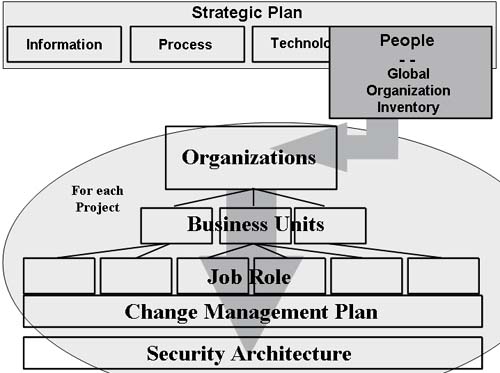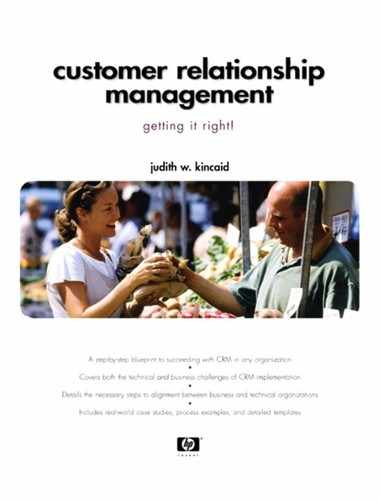14.1. Engineering People?
We're not going to even think about engineering people. We won't be using any clipboards or stop watches to manage the people component. In fact, this component isn't about work at all; we already looked at what needs to be done in Chapter 12 when we discussed the process component. Rather, when we talk about the people component, we are talking about helping people to change their behavior. The dictionary defines change to mean “to make different,” and behavior is defined as “the way in which some[one] functions or operates.”
|
As we discussed earlier, organizations were originally created to improve the way work gets done. People doing similar jobs all reported into the same organization.
14.1.1. Understanding Why Change Is So Difficult
People don't like change; often, we are afraid of the unknown. Even very positive changes like getting a promotion or buying a new house are stressful because there is still something lost—the old team and all the stuff you know how to do, or the old neighborhood, schools and shops.
For our purposes, there are four stages that people must work through whenever they are faced with change. These behavioral stages are actually a learning process and not all that different from what happens when people learn anything new. Consider, for example, learning to ride a two-wheel bicycle. People often start by believing that the change isn't really going to happen or won't have much impact – sort of like putting training wheels on your bike; it's not all that different from riding a tricycle. When we finally take the training wheels off, we often get angry, sad, or frustrated because it's just so hard to stay upright. Anyway, it's not our fault because we can't practice without help from Mom or Dad and they're always too busy. Then there is a breakthrough when we start to understand what's different, and, at least for a moment or two, we start to figure out this thing called balance. Finally, we get it! It seems like a miracle; not only have we mastered the balance thing, but we've also found out how much faster and farther we can go on two wheels with much less work. It did just take practice after all.
Change represents the end of something and the start of something new. Getting from one state to the other requires going through a transition that includes the four stages shown in Figure 14-1.
Figure 14-1. Dealing with change

The transition takes time. Change, even for the better, still represents a loss of some kind. The purpose of the people component is to make the transition as short as possible, returning people to a level of productivity that is at least as good as it was before we started the transition. The first and most important thing we can do is to understand that individuals go through a process to accept change. With this knowledge, we can be prepared to provide as much support as possible.
14.1.2. Supporting Change
If our CRM program is to be successful, we want to see two big changes in the behavior of those individuals who interact directly with customers and help form the total customer experience. These individuals are certainly employees, but also include contract workers and third party service providers. All of the same basic behavior requirements apply, though of course the methods for governing change are not the same for individuals not directly employed by your company. We will use the term “employee” to include all individuals who work on your company's behalf, no matter who pays their salary.
Employees will change what gets done and ensure that they understand our customer interactions from the customer's point of view
Employees will change how things get done, and we will make sure that everyone understands how to use all the new tools, information, and process
We know it's unrealistic to expect people to flock instantly to the adoption of these kinds of changes, but how can we support and encourage the transition? Table 14-1 lists the tools that are available to assist employees through the change ahead.
| Denial | Resistance | Investigation | Acceptance | |
|---|---|---|---|---|
| Communication | X | X | X | X |
| Training and Education | X | X | X | |
| Metrics and Rewards | X | X |
All three of the tools listed in Table 14-1 are critical to successful implementation, but it is not surprising that the first of these is communication!
14.1.3. Engineering Change
By now, we can't be surprised that engineering the kind of change required by a CRM program requires input and perspective from both business experts and technology experts. For this component, the responsibility for the engineering process resides primarily within the business function, but Information Technology has lots to contribute, too.
Behavioral change requires a clear understanding of the company's strategy and direction. This must be the motivational driver behind the change that is taking place. So where do we start? Just like always: We begin with a high-level understanding of the organization and its business goals. Next, we focus on the Valencia project and identify the business units that will be impacted, and particularly the job roles of individuals who will be making any required changes in their behavior. Then, we will define a change management plan that we will use to manage the communication, training, and rewards that support and encourage transition. The remaining view, the security architecture, is primarily the responsibility of the IT team, although business management must identify specific individuals and what they are authorized to access. Figure 14-2 illustrates the change engineering process steps.
Figure 14-2. Engineering change

We will work down through each of these views as we have for all the other components. Each view depends on the previous, and each adds lower levels of detail about what's required.

